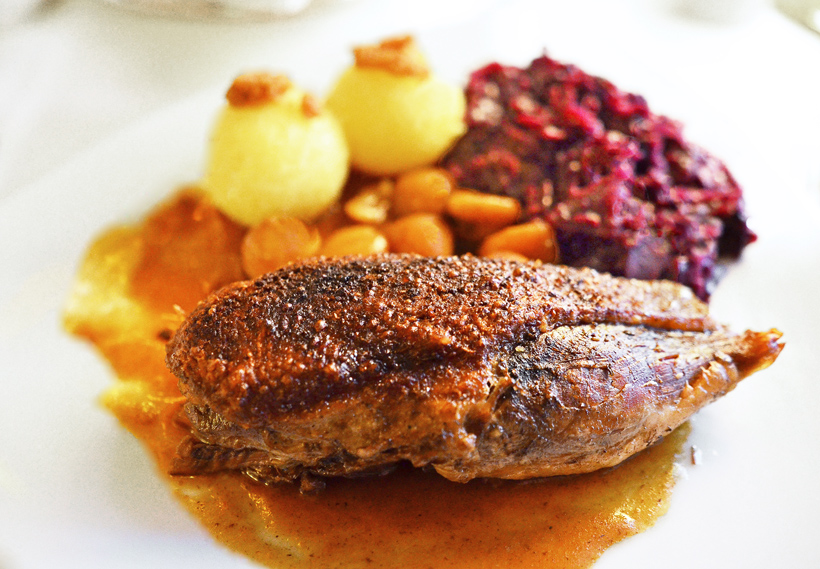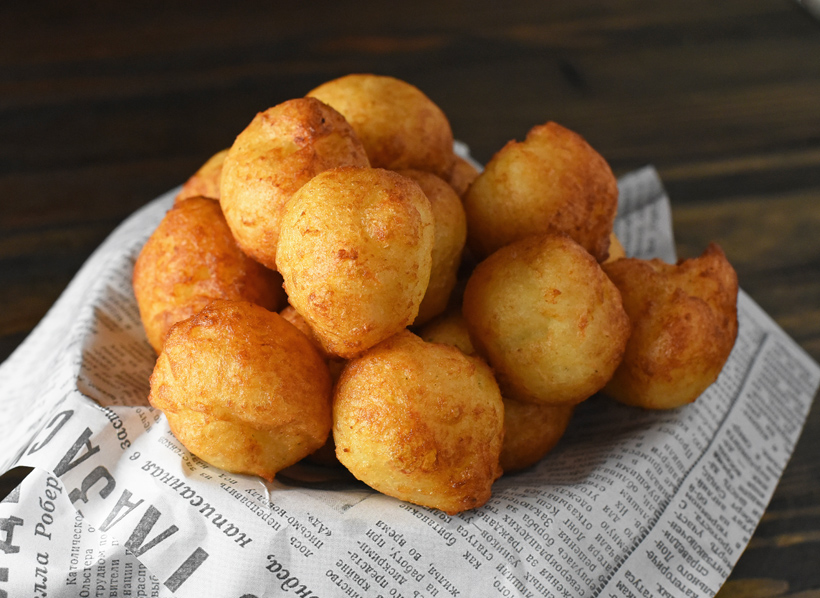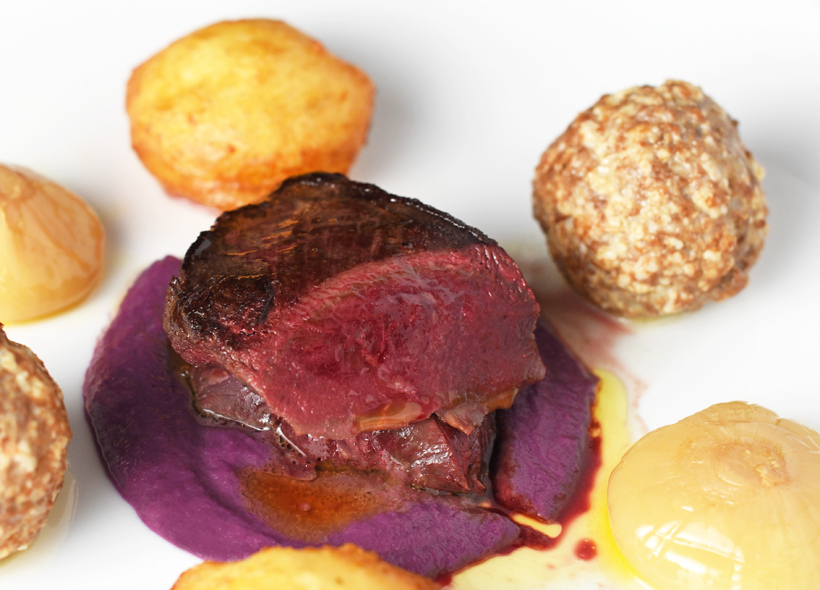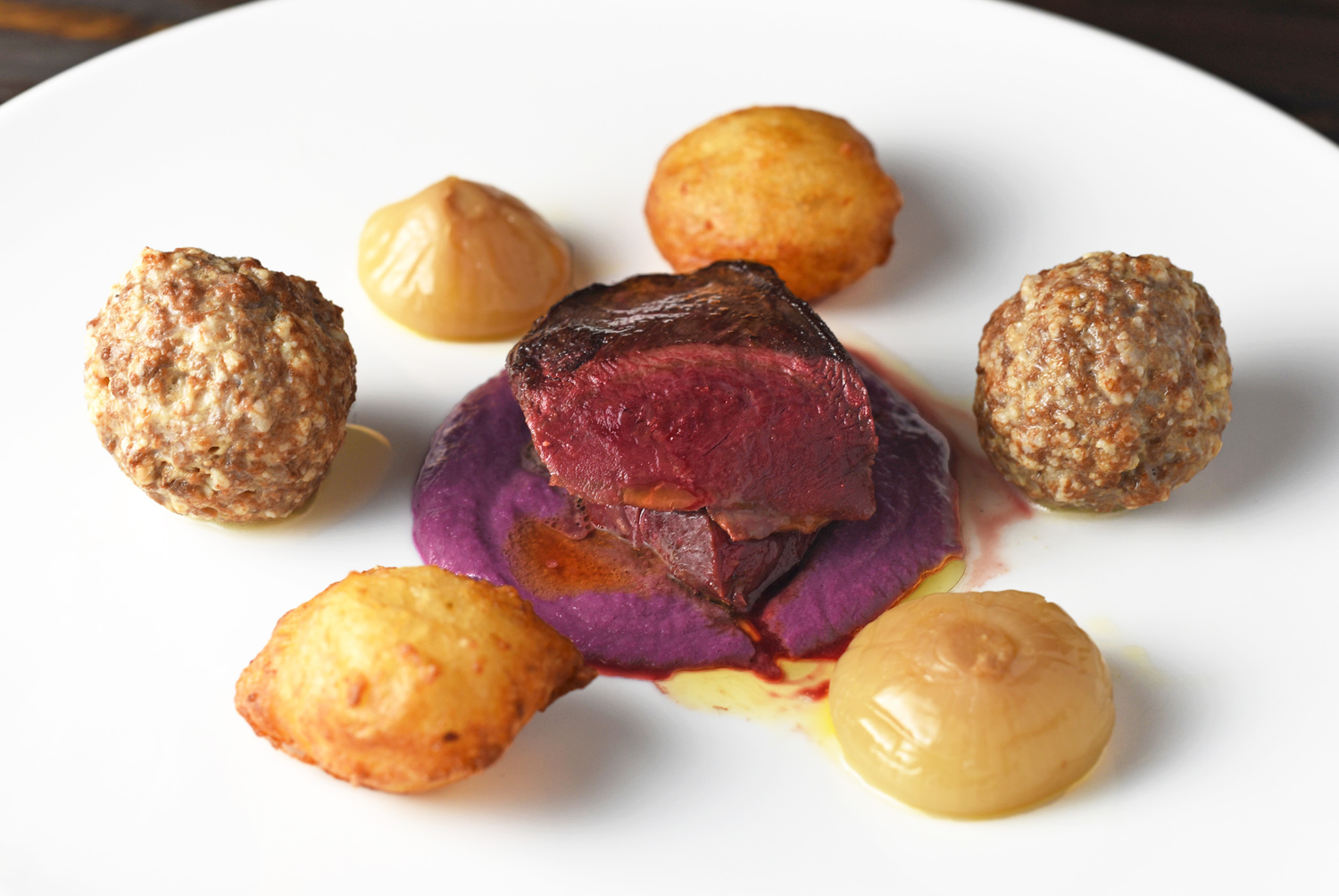There are few places where duck is as ubiquitous a culinary staple as in Central Europe, in particular Germany, Hungary, Czech Republic, and Slovakia (the other places would be France, China, and Southeast Asia). Roast duck, served with potatoes and red cabbage, seems to be on the menu of every other restaurant, prepared this or that way, especially in winter. If the potatoes aren’t puréed, then the cabbage is. Or the cabbage is cooked in sweet red wine, and served with potato croquettes, or potato dumplings. Sometimes there’s a prune here and an onion there. Sometimes it’s just the breast instead of a whole or half bird, and sometimes the duck is really a goose, as in the following photo — and in which case it’s often too tough, so you should take my advice and not order it.

Rothenburg ob der Tauber, Germany – Restaurant Eisenhut – Braised Goose Breast, Glazed Chestnuts, Potato Dumplings, Red Cabbage
However, the inspiration behind this recipe is actually twofold. All aside from the prevalence of duck in Central Europe, I returned home from last fall’s hunting trip with no deer but a decent number of ducks (no, I wasn’t hunting ducks from a tree stand with a big game rifle; these were two separate outings during the same trip upstate). I’ll talk about my adventures with Huntsman / Captain / Musician / Innkeeper Bill in a separate post soon, but obviously these ducks needed to be eaten.
So I’m killing two birds with one stone (sorry, I had to say it), using my wild ducks to reinterpret a Central European classic. This is my version of the duck-potato-red cabbage dish. I’m not crazy about the plating, but the recipe is awesome:
- The duck is wild, and, at least in the US, this means you wouldn’t just roast the whole bird. Not just because the leg meat would be incredibly tough, but also because you shouldn’t eat the skin due to environmental toxins. So you end up mostly with skinless breasts. But these breasts are phenomenal. In fact, I would say they’re the best meat of all the things I’ve hunted, period. I love farmed duck too; it’s an excellent meat and could be used for this recipe with great results. But wild duck boasts the perfect gamey taste, powerful yet not to the point where I would call it an acquired taste. (Or is it that I acquired the taste long ago and don’t even remember?) At the same time, when cooked properly, they’re still very tender, which is much more than I would say about goose.
- There’s still some meat to be picked off the carcasses and the legs, though. Many hunters simply collect the breasts off their ducks. It’s considerably faster, it represents something like 75% of all the meat, and that’s the best part anyway. But since I don’t have to process thousands of ducks a year like the hunting guides do, I take the time to skin the whole carcasses, clean them, and vacuum-seal them using the little portable sous-vide machine that I brought along to Bill’s presidential hotel suites. This extra meat is great if you grind it, hence the meatballs I’m making today. I do realize that my recipe call for more leg meat than most ducks yield, so you’ll have to be creative: throw a duck breast in the mix, add some store-bought duck meat, or add some ground chicken. The meatball recipe is loosely inspired by J. Kenji López-Alt’s The Food Lab: Better Home Cooking Through Science, and the results are pillowy and delicious.
- The cabbage purée is meant to go with the duck. On its own, it may not be the best you’ve had, but it’s perfect with the duck. It’s well-balanced, just slightly sweet and slightly sour. Too often, red cabbage preparations are too sweet — this is not a dessert!
- Next, the potato croquettes. The name has come to evoke something purchased in the frozen food aisle of the supermarket, something with a suspiciously crispy shell containing a dense glob of insipid mashed potatoes. That’s not what I had in mind! I wanted something airy that tasted like potatoes. Two slightly conflicting requirements, because in order to remain airy the croquettes need gluten, which isn’t found in potatoes. I could probably have learned something from gluten-free baking recipes, where xanthan gum is added for binding. Or I could have just bought gluten. But for this time, I stuck to basic ingredients and simply tweaked the proportions over many iterations until I got the right results. Sooner or later, I’ll go back to this recipe and try something else.
- Finally, my recipe contains both onions (caramelized) and prunes (in the meatballs), so I can proudly claim to have gathered as many traditional ingredients and clichéed pairings as possible in a single dish!

Caramelized onions
Yields 4 servings
40 g butter
40 g water
8 cipollini onions (about 250 g), skin on
salt
- In a saucepan over low heat, melt the butter in the water. Add the onions with their skin on, and cover with a lid. Cook on the lowest possible heat for 45 minutes, flipping the onions halfway through. Let cool for 5 minutes.
- Peel the onions, transfer to a bowl, then pour some of the cooking liquid on top, season with salt, and reserve.
- Alternate method, for sous-vide enthusiasts: skip of all the steps above. Instead, vacuum-seal the peeled onions with the butter and salt but without the water, and cook them in a 90 C / 200 F water bath for about 6 hours.
Potato dumplings
Yields about 8 servings (16 dumplings)
2 g active dry yeast
30 g milk, lukewarm
200 g peeled Yukon Gold potatoes, halved
25 g butter
65 g flour
2 g salt
black pepper, ground
1 pinch ground nutmeg
canola oil (for deep-frying)
- Combine the yeast and milk, and let rest for 5 minutes.
- Cook the potatoes in unsalted boiling water until tender. Drain, and let cool for 5 minutes (this is important, as it also dries out the potatoes a bit).
- Rice the potatoes into the bowl of an electric mixer fit with the paddle attachment. Mixing on medium speed, add the butter, followed by the flour, salt, pepper, and nutmeg. Wait until the potatoes aren’t too hot (no more than 37 C / 100 F), then add the yeast mixture. Cover, and let rise 1 1/2 to 2 hours, until doubled in volume.
- Transfer the dough to the refrigerator, and chill for at least 1 hour. (It must be cold, otherwise you won’t be able to shape the dumplings in the next step.)
- Heat the canola oil to 180 C / 360 F in a pot, for deep-frying.
- Before serving, roll the dough into 3 cm diameter balls with wet hands. Gently drop the balls into the oil, and cook until golden brown, flipping them several times. Drain on paper towels, and keep in a warm place.

Red cabbage purée
Yields about 4 servings
40 g peeled shallots, small dice
40 g butter
200 g red cabbage, thinly sliced
salt
black pepper, ground
1.6 g ground cumin
0.1 g ground nutmeg
120 g red wine
4 g red wine vinegar
2.5 g sugar
- In a saucepan over medium heat, sauté the shallots in half of the butter until translucent.
- Add the red cabbage, season with salt and pepper, and sauté for a couple minutes. Stir in the cumin and nutmeg, then add the wine and vinegar. Simmer for a couple more minutes, cover, and cook over low heat for 15 minutes or so, until tender.
- Transfer the mixture to a blender, add the sugar and the rest of the butter, and process until smooth. Pass through a chinois, and reserve.
Duck meatballs
Yields slightly over 4 servings (8 meatballs)
4 g powdered gelatin
140 g heavy cream
40 g white bread, crust removed, medium dice
300 g duck meat without skin or fat (picked from the legs, wings, or carcass)
40 g egg, beaten
40 g grated Swiss cheese
1 g ground cumin
0.2 g ground black pepper
3.5 g salt
9 pitted prunes (about 70 g)
about 1500 g canola oil (for deep-frying)
- Sprinkle the gelatin over 40 g of the heavy cream, and let rest for 10 minutes.
- Add the bread to the heavy cream mixture, and allow to soak for 10 minutes, mixing occasionally.
- Grind the duck meat in a meat grinder using the large die.
- In a bowl, combine the meat, bread mixture, egg, cheese, cumin, pepper, and salt. Grind in a meat grinder all together, again using the large die.
- Divide the mixture into portions of 45 g each. Proceeding one at a time, flatten into a disc, place a prune in the middle, and fold into a ball.
- Fill a pot with 3-4 cm of canola oil, and heat to 175 C / 350 F.
- Deep-fry the meatballs for 2-3 minutes, until brown on all sides, then drain on paper towels.
- Transfer to a sous-vide pouch with the remaining 100 g of heavy cream, and vacuum-seal.
- Cook in a 57 C / 135 F water bath for 1 ½ hours, then reserve.

Sous-vide duck breasts
Yields 4 servings
300 g wild duck breasts
salt
black pepper, ground
25 g butter, sliced
- Season the duck breasts with salt and pepper. Place in a sous-vide pouch with the butter, and vacuum-seal.
- Cook in 50 C / 125 F water bath for 30 minutes, and proceed to assembly.
Assembly
Yields 4 servings
potato dumplings
sous-vide duck breasts
salt
canola oil
caramelized onions
red cabbage purée
duck meatballs
- This is the time to deep-fry your potato dumplings (see above). If you’ve already done so, you can fry them a second time for a few seconds just to reheat them.
- Take the duck breasts out of their sous-vide pouch. Lightly season with salt (they’ve already been salted once). Sauté in canola oil in a very hot pan just long enough to brown on both sides. Reserve.
- Reheat the caramelized onions and the red cabbage purée (don’t tell anybody, but a few seconds in the microwave works just great).
- Take the duck meatballs out of their sous-vide pouch.
- On each plate, spread a disc of red cabbage purée in the center. Top with pieces of duck breast drizzled with some of the butter from the sous-vide pouch. Surround, in an alternating pattern, with two caramelized onions, two dumplings, and two meatballs drizzled with some of the cream from the sous-vide pouch. Serve!


